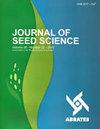X-ray, multispectral and chlorophyll fluorescence images: innovative methods for evaluating the physiological potential of rice seeds
IF 1.2
4区 农林科学
Q3 AGRONOMY
引用次数: 0
Abstract
Abstract: Image analysis techniques are expanding in agriculture and, for being fast, simple, and not destroying samples, they are interesting alternatives in the detection of immature rice seeds. Therefore, the aim of this study was to evaluate the quality of rice seeds using X-ray, multispectral and chlorophyll fluorescence image analysis techniques. Initially, with the seeds identified and numbered, radiographic images were obtained to determine the free space (area between the endosperm + embryo and the glumes). Subsequently, with the same seeds used in the X-ray, multispectral and chlorophyll fluorescence images were acquired, and then the computerized seedling analysis was performed with the SVIS® software. It was concluded that rice seeds that do not germinate or originate abnormal seedlings have free space equal to or greater than 18.68%, higher reflectance in the spectral bands with wavelength from 590 nm to 780 nm (41.46% to 64.21%, respectively) and in the band of 970 nm (75.65%), in addition to having chlorophyll fluorescence values equal to or greater than 40.58 and 112.92 at excitation/emission energies of 630/700 nm and 645/700 nm, respectively.x射线、多光谱和叶绿素荧光图像:评估水稻种子生理潜能的创新方法
摘要:图像分析技术在农业领域的应用越来越广泛,由于其快速、简单、不破坏样品等优点,在水稻未成熟种子检测中具有重要的替代意义。因此,本研究的目的是利用x射线、多光谱和叶绿素荧光图像分析技术来评价水稻种子的质量。首先,对种子进行识别和编号,获得射线图像以确定自由空间(胚乳+胚胎与颖片之间的区域)。随后,使用x射线中使用的相同种子,获取多光谱和叶绿素荧光图像,然后使用SVIS®软件进行计算机化幼苗分析。结果表明,未发芽或未形成异常苗的水稻种子自由空间大于18.68%,在590 ~ 780 nm波段(分别为41.46% ~ 64.21%)和970 nm波段(75.65%)的反射率较高,在630/700 nm和645/700 nm激发/发射能量下,叶绿素荧光值分别大于40.58和112.92。
本文章由计算机程序翻译,如有差异,请以英文原文为准。
求助全文
约1分钟内获得全文
求助全文
来源期刊

Journal of Seed Science
Agricultural and Biological Sciences-Agronomy and Crop Science
CiteScore
2.00
自引率
30.00%
发文量
28
审稿时长
12 weeks
期刊介绍:
From 2017 the Journal of Seed Science (JSS) will circulate online version only.
Original scientific studies and communications, not yet published or submitted to another journal for publication and written in Portuguese or English, will be accepted for publication. For manuscripts submitted in English, the authors should provide an adequated version.
The SCIENTIFIC COMMUNICATION is a category of scientific manuscript which describes a technique, an equipment, new species or observations and surveys of limited results. It has the same scientific rigor as the “Scientific Articles” and the same value as a publication. The classification of a manuscript as a SCIENTIFIC COMMUNICATION is based on its content and scientific merit but it can be a preliminary study, simple and not definitive on a certain subject, with publication justified by its uniqueness and contribution to the area.
The Editorial Board of the JSS may invite leading authors of recognized reputation to compose specific Review Articles covering topics of their specialization that will convey to the scientific community the state-of-the-art knowledge related to the specific theme.
 求助内容:
求助内容: 应助结果提醒方式:
应助结果提醒方式:


